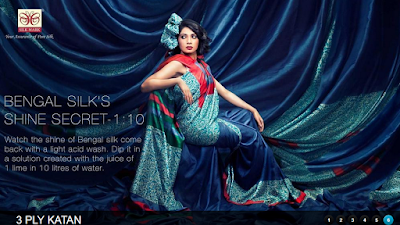Bishnupur, (also called Vishnupur) is a town and area in the Bankura locale of West Bengal. It is named after Lord Vishnu, who was adored by the Malla rulers in the midst of the seventeenth and eighteenth many years and was the capital of the Malla kingdom.It is outstanding for its legacy of delivering silk sarees, particularly the sumptuous Bishnupuri Silk Saree the baluchari silk sarees. What's more, Bishnupur additionally creates fine, light-weight Bishnupuri Silk Saree that have a delicate, smooth surface and wrap wonderfully.
History of Bishnupuri Silk Saree
Bishnupuri Silk Saree comes back to a couple of hundred years. It is known to have flourished in the eighteenth and mid nineteenth many years when the East India Company traded weaved scarves and organic surfaces for dresses made of fine Bishnupuri Silk Saree .
In the interim, around 200 kms away, in another silk delivering region of Bengal, Murshidabad, the weaving of the Bishnupuri Silk Saree bloomed under regal support of the Nawabs of Bengal. The Bishnupuri Silk Saree were settled on the banks of the stream Bhagirathi, however a flooding of the waterway made them evacuate themselves and move to Bishnupur. Exchange continuously declined under the British realm and the deluge of modest factory made texture from England joined with budgetary authorizes in the long run crushed the baluchari weavers out of their specialty.
The recuperation of Bishnupuri Silk Saree in the mid twentieth century was accomplished by the specialist Subho Thakur, who developed the method of jacquard weaving that staggeringly streamlined the system and reduced the time it took to weave a Bishnupuri Silk Saree . This new time of Bishnupuri Silk Saree weaving features subjects from adventures and religious messages, and is continued right up 'til the here and now by the weavers of Bishnupur.
Baluchari weaving, Bengal
Bishnupuri Silk Saree weaving continues being a basic lodge industry in Bishnupur, and about 15% of its people is used in the handloom territory today. Regardless, the region isn't genuinely suitable for silk sarees raising or mulberry improvement, and a huge bit of the unrefined silk used here begins from other silk making regions, for instance, Murshidabad and Malda. Despite Bishnupuri Silk Saree , unadulterated silk sarees with square printed, destructive printed and Bishnupuri Silk Saree structures are ordinary. These sarees are incredibly light and blustery and touch base in a variety of tones with ordinary similarly as whimsical structures. They are sensitive and easy to wrap and are sensible for both agreeable and formal wear.



















